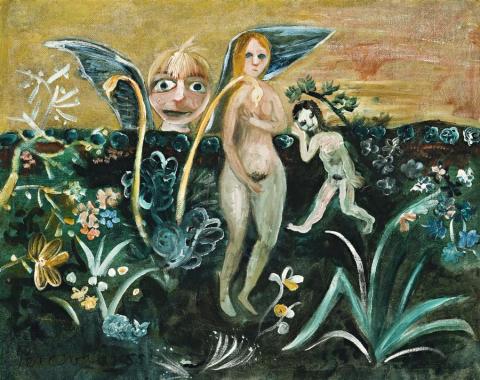ADAM AND EVE WITH GARLIC PLANT, 1952-55
John Perceval
tempera and resin with enamels on composition board
72.5 x 91.0 cm
signed and dated lower left: Perceval 55, inscribed verso: Adam + Eve 1955
Private collection, Melbourne
Lauraine Diggins Fine Art, Melbourne
Private collection, Melbourne
Selected Australian Works of Art, Lauraine Diggins Fine Art, Melbourne, June 1986, cat. 52
Annual Collectors' Exhibition 2001, Lauraine Diggins Fine Art, Melbourne, 16 June – 14 July 2001, cat. 65
Australian Modern: Arte Australiana Moderna e Contemporanea e Arte Aborigena, Fondazione Mudima, Milan, 23 April – 24 May, 2002
Heavenly Creatures, Heide Museum of Modern Art, Melbourne, 4 December 2004 – 30 January 2005
Plant, M., John Perceval, Lansdowne Press Pty Ltd, Melbourne, 1971, pp. 52, 54 (illus.)
Allen, T., John Perceval, Melbourne University Press, Melbourne, 1992, pp. 91, 112, 114, 155 (illus.)
Australian Modern: Arte Australiana Moderna e Contemporanea e Arte Aborigena , Malakoff Fine Art Press, Melbourne, 2002, p. 12 (illus.)
John Perceval's Adam and Eve with Garlic Plant provides a witty and highly individual interpretation of the story of the Fall of Man and expulsion from the Garden of Eden in the Book of Genesis. The visualisation of the story over many centuries of Western art is so set in tradition that Perceval's humorous presentation comes as a bit of fun, the progressive revelation of his ideas adding greatly to its enjoyment. This is extended through the naivety of his adopted style with its sense of immediacy, in keeping with his other paintings of the time. Using haptic proportion - the more important the person the bigger their size - Perceval launches the narrative with a proper sense of order. The Archangel sent by God to drive Adam and Eve out of Eden dominates, in close connection with Eve, while Adam is a minor figure recessed into the background. The Archangel has a child-like look that we find in Perceval's paintings of children and gives a foretaste of those brilliant ceramic sculptures of Angels soon to come. Linked to Eve by a protective wing, Perceval paints playfully with illusion and composition. Overall the presentation is quite flat, with very little depth of field, allowing the face of the Archangel to advance almost to the picture's surface. Eve is caught between that same surface and its depth, with Adam a mere guilty bystander.
The moment depicted is Adam and Eve cast out into a world of lush though foreign landscape, the plant forms being of such lively character that, by comparison with the tragic figures of Adam and Eve, they almost dance across the painting's surface. The focus on Eve is in line with her role as the central figure in the Fall. Translated from the classical Venus Pudica type, she covers her private parts in shame in the new awareness of her nakedness, having eaten from the forbidden fruit of the Tree of Knowledge. Presentation is full and frontal. And an impish Archangel looks on from the Garden of Eden on the other side of the wall. With mischievous delight Perceval introduces the garlic plant, allowing one of its snakehead like tendrils to nestle in Eve's bosom. While referring to the snake's tempting enticement to eat the forbidden fruit, the alliance leads to notions of the femme fatale and male weakness before the sexual temptations embodied in woman. But why garlic, the ancient protector against evil? The replacement of the apple of tradition with garlic and its repelling fumes no doubt amused the artist.
This painting relates to a group of family subjects and portraits from the early 1950s which chose the artist's three children Mathew, Tessa and Celia (Winkie) as subjects. A wide-eyed innocence is portrayed in paintings such as Winkie and Tessa in Blackman's Chair, 1952, and Mathew, Tessa and Winkie in a Field of Flowers, 1954.
DAVID THOMAS
